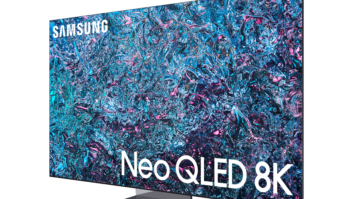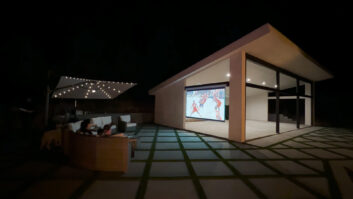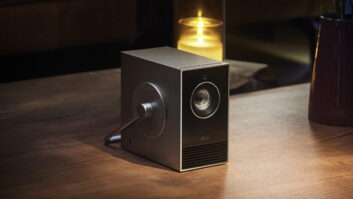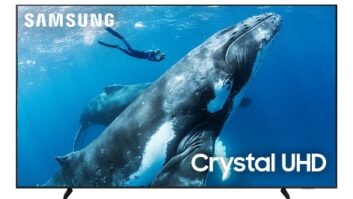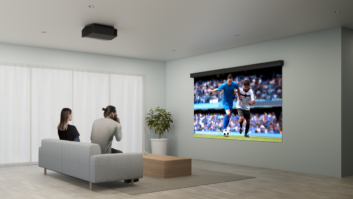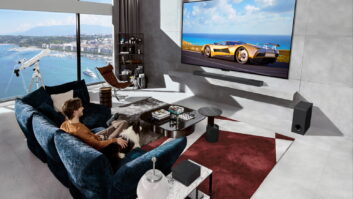Monday is the official press day prior to the opening of another International CES. And press day is when the major video companies—LG, Sharp, Panasonic, Samsung, and Sony—corral thousands of technology writers from around the world to show their latest product introductions that will be driving market and technology trends in the coming year.
Here’s a rundown of what these companies had to say, and, not surprisingly, 4K was a dominant part of the conversations.
LG:

With HomeChat technology, LG will allow users to talk to their “appliance things” around them using natural language and integrated messaging.
“With LG, it’s all possible” is the company’s slogan for the year, and it touted the benefits of delivering smart technology but without complexity: smart but simple.

LG hopes to make TV simple again with a new set-up wizard on its TVs.
LG gained market share in in each of its key market categories in the U.S. in 2013: TV, smartphones, and appliances, which speaks volumes about its momentum coming into 2014, according to the company.
With so many disparate devices using their own apps and control protocols, LG talked about simplifying the integration between devices. This technology, which LG is calling HomeChat, forms part of a broader vision, and LG hopes to simplify things by allowing users to talk to their “appliance things” around them using natural language and integrated messaging. Text your fridge, “Do we have any beer?” and it will reply with an inventory. Tell home, “I’m coming home at 8:30,” and it will adjust settings accordingly.

Reed Hastings, Netflix CEO.
LG also said there are 160 million smart TVs in the market, but people think they’re too complicated to use. LG wants to make TV simple again—simple connection, simple switching, and simple discovery using a new set-up wizard on its TVs.
Back in 2008, LG was the first company to offer Netflix integration by putting its streaming service in a BD player. This year, Reed Hastings, Netflix CEO joined the LG press conference to announce that real-time, 4K streaming from Netflix will be coming this year on LG TVs, with “House of Cards” being filmed in 4K.
Despite the speculation that Panasonic pulling out of the plasma market might be the end of the technology, LG assured that it will continue to have plasma in 2014.

LG is also introducing six new series and 12 new models in Ultra HD, ranging from 49 to 105 inches. The sets will support all the latest Ultra HD standards, including HDMI 2.0, HDCP 2.2 and HEVC H.265. The company also worked with Harman/Kardon to improve audio on these UHD sets, and some models will incorporate dual subwoofers.
The big news was the introduction of the 105-inch Ultra HD curved LED TV, in a cinematic 21:9 aspect ratio. A 77-inch Ultra HD curved OLED is expected to hit in June.
LG claims it is well positioned to dominate the OLED market in 2014 and beyond, with four new series and five OLED models overall ranging from 55 to 77 inches.
Sharp:
Sharp began its CES presentation by claiming it holds more than 55 percent market share in the pro AV market in sizes over 60 inches. The most exciting new technology in that space is IGZO, a combination of Indium, Gallium, Zinc, and Oxygen introduced at last year’s CES. Sharp is the first company in the world to successfully produce IGZO, which is being incorporated by other brands like Dell and NEC.

Sharp’s 2014 TV lineup.
Sharp claims it will continue to innovate and dominate the TV market in the large screen sizes, which Sharp defines as 60 inches and larger; 84 percent of TVs purchased in the U.S. are 60-, 70-, 80-, and 90-inch screen sizes, according to the company.
Picture quality, smart, size, and design are the elements behind Sharp’s TV designs for 2014, in four lines. At the entry level is AQUOS HD, designed for high-quality large TV. Next is AQUOS Q Full HD with Quattron fourth sub-pixel technology that can deliver one billion more colors than traditional TVs. Next up is the new AQUOS Quattron+ series with proprietary Revelation technology. This produces 10 million more subpixels than full HD, producing more detail, depth, and color. It offers the highest resolution full HDTV screen available with 16 million subpixels. Further, this will be the only HD sets able to play full 4K content and will retail for about half the cost of today’s 4K TVs.
Finally, the top-of-the-line AQUOS 4K is designed for the consumer that wants the ultimate experience. It is also the first THX-certified 4K display.

Sharp’s AQUOS 4K display.
Sharp partnered with THX and RED Digital Cinema for a 4K short film competition, titled “The Art of Amazing.” Sharp representatives said that the excitement about high resolution is building and that the company’s campaign will be, “Miss Nothing. Experience Everything.” Sharp is showing these 4K shorts in its booth at CES.
Showing that the resolution race won’t stop at 4K, Sharp is also demonstrating two 8K models, including one 85-inch model and another demonstrating glasses-free 3D TV.
Sharp is looking to make its smart TVs smarter and easier to use with the new SmartCentral. This will better seek out programming that interests a consumer’s viewing preferences, searching across platforms—cable, streaming, etc.—to help them discover content they didn’t even know they had access to.

Finally, Sharp showed its new universal player. This Blu-ray/SACD device supports WiSA and WiHD wireless with a built-in transmitter that supports lossless 96/24 up to 7.1-channel audio and uncompressed 1080p video.
Panasonic:
Panasonic is focusing on moving beyond the living room and into other areas of the home, even into what consumers wear and drive. It is also looking to bring 4K technology to business customers and intends to lead 4K tech in the business community. The company is also launching a new 4K Varicam to deliver very affordable 4K video production.
Panasonic tried to entice members of the press to venture over to its booth to see a 21-foot long 4K OLED video wave-wall combining curved and concave panels.
For its next generation of smart TVs, Panasonic is looking to redefine what a 21st Century TV can and should be. Its new sets with Life+Screen technology will take consumers “beyond smart TV” to a new level of interaction and experience. Life+Screen will know what a consumer and her family love to watch and will have the content waiting for them to watch when they turn the TV on. Additionally, sets will be able to recognize a consumer by face or voice or turn on and display content relevant to an individual when he or she walks by.
The only mention of plasma was that Panasonic promised to deliver plasma-quality performance with LED TV in 2014. Further, Panasonic is launching the first 85-inch 4K LED model later this year.
Samsung:
Samsung stated that Ultra HD is going to drive the next change in the TV industry, but that not all UHD sets are created equal. UHD TVs will lead market growth, with estimates predicting 60 million units sold by 2015.

The evolution of Samsung TV sets.
Samsung showed its own version of a 105-inch curved UHD TV, also in 21×9 aspect, which it claims is the world’s largest curved UHD TV. The set has 11 million pixels and a 5120×2160 screen resolution.
They brought out producer Michael Bay to presumably discuss the advantages of Samsung UHD TV and curved screens, but there was a problem with the teleprompter seconds after Bay took the stage, and after noting said problem, Bay turned his back to the audience, paused a beat, and then awkwardly just walked off the stage. It was pretty uncomfortable to watch and a major hiccup in the presentation, but that’s what happens with live events. Apparently, Bay was supposed to announce that he will exclusively release the first preview of his “Transformers 4” movie on Samsung UHD TV.
Following Bay’s sudden departure, the Samsung exec smoothly picked up the ball and kept moving forward. This spring Samsung will release a UHD video pack pre-loaded with 4K content allowing owners to experience the best, high-resolution content in their homes. Samsung is also partnering with other streaming content providers like Amazon, Comcast, DIRECTV, M-GO and Netflix to deliver more UHD content to customers.
A new multi-link screen will allow users to view live TV while browsing for content, letting users search sports stats or movie information right on the screen without missing any of the action.
Samsung introduced another new display incorporating what it calls “bendable technology.” The set can transform from flat to curved at the touch of a button, which is “all about giving the customer total control over their viewing experience.”
Sony:
Recently appointed Sony president and CEO Mike Fasulo made his debut leading the annual late-afternoon press conference by declaring, “This year is all about play.”

Sony president and CEO Mike Fasulo introduces the company’s strategies for 2014.
Naturally, 4K is at the forefront of this strategy, which Sony uniquely highlights with an end-to-end solution spearheading 4K content creation, production, distribution, and of course, display. Sony has the live 4K infrastructure, “from lens to living room.”
Fasulo touted Sony’s Video Unlimited native 4K-download service, launched in September, but it is expanding the library and adding a decoder compatible with the HEVC compression format being built into new products.

Netflix CEO Reed Hastings made an appearance to again plug new 4K streaming from Netflix including the acclaimed “House of Cards” series, citing the less than 15mb/s download speed.
Nine new TV models in three series of products ranging from 49 to 85 inches are new from Sony this year. They incorporate Sony’s X Reality PRO picture engine for upscaling content and Triluminos Display for a wide color gamut. The X-tended Dynamic Range technology is new for 2014, creating brighter images and more detail. Larger speakers have been designed in an iconic wedge shape along with ClearAudio+ DSP.
The flagship XBR-X950B series comes in 85 and 65 inches, while the XBR-X900B series comes in 79-, 65-, and 55-inch screen sizes. Sony is also introducing an entry-level 4K model, the XBR-X850B series, in 49-, 55-, 65-, and 70-inch screen sizes. A next-gen 4K media player is something Sony is working on.
The 2014 lineup of Bravia Full HD TVs offer various new features and screens sizes, implementing the X-Reality PRO picture engine.

